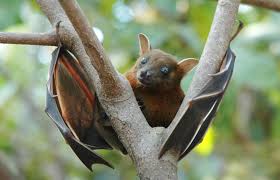Bats Get a Bad Rap, Why?

A cute short nosed fruit bat.
“They’re basically mice with wings,” English teacher Mr. Jackson said after wondering why bats get a bad rap. Bats are a unique species, known for using their ears to locate, using echolocation. But their looks and their recent fault in starting the COVID-19 pandemic have led bats to get a bad rap. Do bats deserve society’s hate? I’d argue, no.
Bats provide a wide variety of environmental benefits to ecosystems. According to the National Parks Service, different species of bats pollinate plants, eat insects, provide a link in the ecological food chain, and some can even inspire scientific discoveries. Blue Agave and other plants in the subtropical regions of America rely on pollinator bats to be pollinated. If your coffee is sweetened with agave nectar, you have a bat to thank.
The National Parks Service found that insect eating bats provide “more than $3.7 billion worth of pest control each year in the United States” which could be compared to “a teenage boy eating 200 quarter pound burgers” every night. I like hamburgers as much as the next teenage boy, but 200 burgers is going to have some beef with my stomach. If 200 hamburgers does not seem like a big deal to you, imagine those 200 hamburgers are made out of mosquitoes and other pests that the bats consume. Now that’s a lot, huh?
Bats also provide a link in the food chain, meaning they not only eat pests, but feed other predators. Keystone species such as hawks, falcons, and owls, eat bats. In addition, bats will also nurture cave ecosystems. Cave systems are biodiverse ecosystems that can support insects, amphibians, fish, and other small mammals. In order to survive, this ecosystem relies on nutrients brought in from water and animal waste. Bat poop, called guano, provides an abundance of nutrients for a cave system. Bat guano was commonly used as high quality fertilizer before nitrogen fixation was industrialized during World War I.
Even outside of the United States, countries such as the United Kingdom use bats as environmental indicators. Environmental indicators are sensitive species that better showcase if an ecosystem is healthy or not. According to the Bat Conservation Trust, bats account “for almost a third of all mammal species in the UK and occupy a wide range of habitats such as, wetlands, woodlands, farmlands, as well as urban areas.” Because of bats’ widespread population and their sensitivity to landscape change, agricultural infestation, urban development, and habitat fragmentation, they make an excellent environmental indicator. If the bat population were to suddenly drop, it could be a sign of an ecosystem collapse, water contamination, or disease outbreak. Biologists and ecologists use indicator species such as bats as early warning signs for biological threats.
Bats not only help the environment, but help inspire science. According to the Bureau of Land Management (BLM), some scientists have been studying vampire bat saliva. The saliva has been found to contain anticoagulants which help prevent blood from clotting. These anticoagulants are currently being developed as treatment for heart disease patients.
Bat wings have also inspired engineers to build drone prototypes with similar features of a bat’s thin and flexible wing. These drones are equipped with smaller and more efficient sonar navigation systems that were inspired from bat’s echolocation. Suits are being made for base jumpers that take the same wing qualities from bats to help boost the suit’s efficiency.
However, the bad rep of bats is not without cause. Bats have helped spread a lot of disease throughout history such as the SARS outbreak in 2002-2004, the MERS outbreak ten years later, and the COVID-19 outbreak of our current pandemic. Washington Post writer, Rachel Ehrenerg, reported that bats have also been found to carry Ebola, Hendra, Marburg, and Nipah virus. The living conditions bats make them prime carries for various diseases.
But bats don’t get sick by these deadly viruses because of their unique immune system. Although these immune systems make them even more ideal for spreading the next pandemic, they also provide a means for scientific research and medical development. Scientists have already discovered some of the genes that make proteins called “interferons” which are the initial response protein in most mammals. In fact, some viruses like COVID-19 are deadly because of the interferon’s reaction in the body. Bats have special genes that make the protein constantly without the alarm of a viral infection. The reduction in the protein reduces the reaction the bat faces with an infection, but still prevents the virus from damaging the bat’s biological system. So bats may help spread viruses because they are infected by more viruses, but we can learn how to deal with viruses from bats.
In fact, the most common ways to get viruses transmitted from bats is when humans interfere with their lives. Through their droppings, segmenting their territory, and consuming the bat can all lead to infection transmission. Bats can pass disease, but only if a human tries to interfere with the bat.
The bad rap of bats seems to be exaggerated, given how bats eat our bugs, warn us of unhealthy living conditions, and even help us with the diseases they carry. This diverse creature, with over 1,200 different species of bats, pose numerous environmental, agricultural, and scientific benefits. The next time you see a bat, try to appreciate its wonders, instead of getting all batty.









